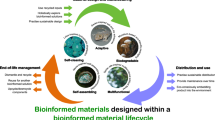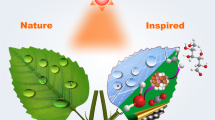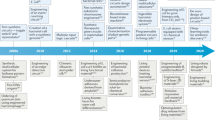Abstract
Efforts to engineer new materials inspired by biological structures are hampered by the lack of genomic data from many model organisms studied in biomimetic research. Here we show that biomimetic engineering can be accelerated by integrating high-throughput RNA-seq with proteomics and advanced materials characterization. This approach can be applied to a broad range of systems, as we illustrate by investigating diverse high-performance biological materials involved in embryo protection, adhesion and predation. In one example, we rapidly engineer recombinant squid sucker ring teeth proteins into a range of structural and functional materials, including nanopatterned surfaces and photo-cross-linked films that exceed the mechanical properties of most natural and synthetic polymers. Integrating RNA-seq with proteomics and materials science facilitates the molecular characterization of natural materials and the effective translation of their molecular designs into a wide range of bio-inspired materials.
This is a preview of subscription content, access via your institution
Access options
Subscribe to this journal
Receive 12 print issues and online access
$209.00 per year
only $17.42 per issue
Buy this article
- Purchase on Springer Link
- Instant access to full article PDF
Prices may be subject to local taxes which are calculated during checkout






Similar content being viewed by others
References
Huebsch, N. & Mooney, D.J. Inspiration and application in the evolution of biomaterials. Nature 462, 426–432 (2009).
Dunlop, J., Weinkamer, R. & Fratzl, P. Artful interfaces within biological materials. Mater. Today 14, 70–78 (2010).
Cranford, S.W., De Boer, J., Van Blitterswijk, C. & Buehler, M.J. Materiomics: an -omics approach to biomaterials research. Adv. Mater. 25, 802–824 (2013).
Boyle, A. & Woolfson, D.N. De novo designed peptides for biological applications. Chem. Soc. Rev. 40, 4295–4306 (2011).
Guvendiren, M., Messersmith, P.B. & Shull, K.R. Self-assembly and adhesion of DOPA-modified methacrylic triblock hydrogels. Biomacromolecules 9, 122–128 (2008).
Hildebrand, M. Diatoms, biomineralization processes, and genomics. Chem. Rev. 108, 4855–4874 (2008).
Suzuki, M. et al. An acidic matrix protein, pif, is a key macromolecule for nacre formation. Science 325, 1388–1390 (2009).
Lee, B.P., Messersmith, P.B., Israelachvili, J.N. & Waite, J.H. Mussel-inspired adhesives and coatings. Annu. Rev. Mater. Res. 41, 99–132 (2011).
Waite, J.H. & Broomell, C.C. Changing environments and structure–property relationships in marine biomaterials. J. Exp. Biol. 215, 873–883 (2012).
Metzker, M.L. Sequencing technologies—the next generation. Nat. Rev. Genet. 11, 31–46 (2010).
Ozsolak, F. & Milos, P.M. RNA sequencing: advances, challenges and opportunities. Nat. Rev. Genet. 12, 87–98 (2011).
Wang, Z., Gerstein, M. & Snyder, M. RNA-seq: a revolutionary tool for transcriptomics. Nat. Rev. Genet. 10, 57–63 (2009).
Garber, M., Grabherr, M.G., Guttman, M. & Trapnell, C. Computational methods for transcriptome annotation and quantification using RNA-seq. Nat. Methods 8, 469–477 (2011).
Miserez, A., Wasko, S., Carpenter, C. & Waite, J.H. Non-entropic and reversible long-range deformation of an encapsulating bioelastomer. Nat. Mater. 8, 910–916 (2009).
Miserez, A. & Guerette, P.A. Phase transition-induced elasticity of α-helical bioelastomeric fibres and networks. Chem. Soc. Rev. 42, 1973–1995 (2013).
Scotto-Lavino, E., Du, G. & Frohman, M.A. 3′ End cDNA amplification using classic RACE. Nat. Protoc. 1, 2742–2745 (2006).
Armstrong, C.T., Vincent, T.L., Green, P.J. & Woolfson, D.N. SCORER 2.0: an agorithm for distinguishing parallel dimeric and trimeric coiled-coil sequences. Bioinformatics 27, 1908–1914 (2011).
Arslan, M., Qin, Z. & Buehler, M.J. Coiled-coil intermediate filament stutter instability and molecular unfolding. Comput. Methods Biomech. Biomed. Engin. 14, 483–489 (2011).
Waite, J.H., Holten-Andersen, N., Jewhurst, S.A. & Sun, C. Mussel adhesion: finding the tricks worth mimicking. J. Adhes. 81, 297–317 (2005).
Harrington, M.J. & Waite, J.H. Holdfast heroics: comparing the molecular and mechanical properties of Mytilus californianus byssal threads. J. Exp. Biol. 210, 4307–4318 (2007).
Zhao, H., Robertson, N., Jewhurst, S.A. & Waite, J.H. Probing the adhesive footprints of Mytilus californianus byssus. J. Biol. Chem. 281, 11090–11096 (2006).
Zhao, H. & Waite, J.H. Proteins in load-bearing junctions: the histidine-rich metal-binding protein of mussel byssus. Biochemistry 45, 14223–14231 (2006).
Yu, J. et al. Mussel protein adhesion depends on interprotein thiol-mediated redox modulation. Nat. Chem. Biol. 7, 588–590 (2011).
Miserez, A. et al. Microstructural and biochemical characterization of the nano-porous sucker rings from Dosidicus gigas. Adv. Mater. 21, 401–406 (2009).
Guerette, P., Gizinger, D., Weber, B. & Gosline, J.M. Silk properties determined by gland-specific expression of a spider fibroin gene family. Science 272, 112–115 (1996).
Gatesy, J., Hayashi, C.Y., Motriuk, D., Woods, J. & Lewis, R. Extreme diversity, conservation, and convergence of spider silk fibroin sequences. Science 291, 2603–2605 (2001).
Yano, M., Nagai, K., Morimoto, K. & Miyamoto, K. Shematrin: a family of glycine-rich structural proteins in the shell of the pearl oyster Pinctada fucata. Comp. Biochem. Physiol. B Biochem. Mol. Biol. 144, 254–262 (2006).
Keten, S., Xu, Z., Ihle, B. & Buehler, M.J. Nanoconfinement controls stiffness, strength and mechanical toughness of beta-sheet crystals in silk. Nat. Mater. 9, 359–367 (2010).
Rousseau, M.-E., Lefevre, T., Beaulieu, L., Asakura, T. & Pezolet, M. Study of protein conformation and orientation in silkworm and spider silk fibers using raman microspectroscopy. Biomacromolecules 5, 2247–2257 (2004).
Steinhart, M. et al. Polymer nanotubes by wetting of ordered porous templates. Science 296, 1997 (2002).
Omenetto, F.G. & Kaplan, D. New opportunities for an ancient material. Science 329, 528–531 (2010).
Tao, H., Kaplan, D.L. & Omenetto, F.G. Silk materials–a road to sustainable high technology. Adv. Mater. 24, 2824–2837 (2012).
Gosline, J.M., Guerette, P.A., Ortlepp, C.S. & Savage, K.N. The mechanical design of spider silks: from fibroins sequence to mechanical function. J. Exp. Biol. 202, 3295–3303 (1999).
Fancy, D.A. & Kodadek, T. Chemistry for the analysis of protein-protein interactions: rapid and efficient cross-linking triggered by long wavelength light. Proc. Natl. Acad. Sci. USA 96, 6020–6024 (1999).
Savage, K.N. & Gosline, J.M. The effect of proline on the network structure of major ampullate silks as inferred from their mechanical and optical properties. J. Exp. Biol. 211, 1937–1947 (2008).
Zok, F. & Miserez, A. Property maps for abrasion resistance of materials. Acta Mater. 55, 6365–6371 (2007).
Hancock, M., Sekeroglu, K. & Demirel, M.C. Bioinspired directional surfaces for adhesion, wetting and transport. Adv. Funct. Mater. 22, 2223–2234 (2012).
Engler, A.J.S.S., Sweeney, H.L. & Discher, D.E. Matrix elasticity directs stem cell lineage specification. Cell 126, 677–689 (2006).
Kim, S.J. et al. Silk inverse opals. Nat. Photonics 6, 818–823 (2012).
Zhang, J. et al. Stabilization of vaccines and antibiotics in silk and eliminating the cold chain. Proc. Natl. Acad. Sci. USA 109, 11981–11986 (2012).
Dickerson, M.B., Sandhage, K.H. & Naik, R.R. Protein- and peptide-directed syntheses of inorganic materials. Chem. Rev. 108, 4935–4978 (2008).
Grabherr, M.G. et al. Full-length transcriptome assembly from RNA-seq data without a reference genome. Nat. Biotechnol. 29, 644–652 (2011).
Li, B. & Dewey, C.N. RSEM: accurate transcript quantification from RNA-seq data with or without a reference genome. BMC Bioinformatics 12, 323 (2011).
Edgar, R.C. Search and custering orders of magnitude faster than BLAST. Bioinformatics 26, 2460–2461 (2010).
Ma, B. et al. PEAKS: powerful software for peptide de novo sequencing by MS/MS. Rapid Commun. Mass Spectrom. 17, 2337–2342 (2003).
Hwang, D.S. et al. Protein- and metal-dependent interactions of a prominent protein in mussel adhesive plaques. J. Biol. Chem. 285, 25850–25858 (2010).
Waite, J.H. & Tanzer, M.L. Specific colorimetric detection of o-diphenols and DOPA-containing peptides. Anal. Biochem. 111, 131–136 (1981).
Larkin, M.A. et al. Clustal W and Clustal X version 2.0. Bioinformatics 23, 2947–2948 (2007).
Roy, A., Kucukural, A. & Zhang, Y. I-TASSER: a unified platform for automated protein structure and function prediction. Nat. Protoc. 5, 725–738 (2010).
Jaenicke, E., Buchler, K., Markl, J., Decker, H. & Barends, T.R.M. Cupredoxin-like domains in haemocyanins. Biochem. J. 426, 373–378 (2010).
Matoba, Y. et al. A molecular mechanism for copper transportation to tyrosinase that is assisted by a metallochaperone, caddie protein. J. Biol. Chem. 286, 30219–30231 (2011).
Sendovski, M., Kanteev, M., Shuster Ben-Yosef, V., Adir, N. & Fishman, A. First structures of an active bacterial tyrosinase reveal copper plasticity. J. Mol. Biol. 405, 227–237 (2011).
Cuff, M.E., Miller, K.I., van Holde, K.E. & Hendrickson, W.A. Crystal structure of a functional unit from octopus hemocyanin. J. Mol. Biol. 278, 855–870 (1998).
Acknowledgements
We are grateful to H. Waite and S. Brenner for insightful discussions and suggestions. We thank J. Weaver, C. Salinas and D. DeMartini for help with Jumbo squid sucker teeth sample collection. G. Muniraj, L. Sellou and C. Sutanto assisted with extraction and purification of P. viridis and squid sucker teeth proteins. V. Gangu provided informatics support and S. Seah provided assistance with tyrosinase modeling. V. Lipik assisted with the acquisition of MALDI-TOF data. W.M. Guo helped with cell culture experiments. We thank K.S. Tan for his advice on snail biology and animal collection. V. Seow, E. Tay and A. Hermawan helped with sample collection and mechanical testing of P. cochlidium egg cases. This research was funded by the Singapore National Research Foundation (NRF) through a NRF Fellowship (A. Miserez), a Singapore Ministry of Education Tier 2 grant (A. Miserez, MOE2011-T2-2-044) and the Agency for Science, Technology and Research (A*Star) of Singapore (S.H., Y.S., F.T.W., V.H.B.H.). M.C.D. and A.P.-F. were supported by US National Institutes of Health grant no. 1R21HL112114-01.
Author information
Authors and Affiliations
Contributions
P.A.G. and S.H. conducted molecular experiments and analyzed sequencing data. S.H. and K.W.K. generated and compiled RNA-seq data. A. Miserez and S.A. conducted and analyzed mechanical testing experiments. Y.S. conducted tyrosinase assays, conducted and analyzed qPCR data, and provided editorial comments. M.R. performed LC MS/MS experiments and analyzed the data with PEAKS. A. Masic conducted and interpreted Raman spectroscopy data. M.C.D. developed the idea of microwave heating of SRT proteins. A.P.-F. and M.C.D. conducted and analyzed the template wetting experiments with native and recombinant proteins and provided editorial comments. P.A.G. conceived and conducted the suckerin fiber and film engineering and characterization experiments and developed and conducted the photo cross-linking experiments. S.A. and G.Z.T. conducted Raman and FTIR experiments on drawn fibers. F.T.W. performed structural modeling of tyrosinases. K.W.K. and D.D. expressed and purified recombinant proteins. V.H.B.H. helped perform and analyze cell culture experiments. A. Miserez, P.A.G. and S.H. designed the study and wrote the paper.
Corresponding author
Ethics declarations
Competing interests
The authors declare no competing financial interests.
Supplementary information
Supplementary Text and Figures
Supplementary Figures 1–6 and Supplementary Tables 1 and 2 (PDF 7181 kb)
Rights and permissions
About this article
Cite this article
Guerette, P., Hoon, S., Seow, Y. et al. Accelerating the design of biomimetic materials by integrating RNA-seq with proteomics and materials science. Nat Biotechnol 31, 908–915 (2013). https://doi.org/10.1038/nbt.2671
Received:
Accepted:
Published:
Issue Date:
DOI: https://doi.org/10.1038/nbt.2671
This article is cited by
-
Plastics in the environment as potential threat to life: an overview
Environmental Science and Pollution Research (2022)
-
Evolutionary development of the cephalopod arm armature: a review
Swiss Journal of Palaeontology (2021)
-
Genomics and transcriptomics of the green mussel explain the durability of its byssus
Scientific Reports (2021)
-
Mussel biology: from the byssus to ecology and physiology, including microplastic ingestion and deep-sea adaptations
Fisheries Science (2021)
-
Sea anemones (Exaiptasia pallida) use a secreted adhesive and complex pedal disc morphology for surface attachment
BMC Zoology (2020)



